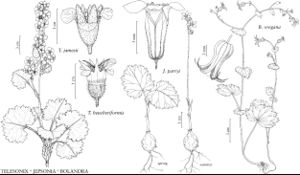Telesonix
Fl. Tellur. 2: 69. 1837 ,.
Herbs, rhizomatous, not stoloniferous; rhizome branched, scaly. Flowering stems erect, leafy, 3–23 cm, densely stipitate-glandular and eglandular-pubescent. Leaves in basal rosettes and cauline; cauline reduced distally; stipules expanded from petiole base; petiole stipitate-glandular; blade usually reniform, sometimes orbiculate-cordate, sometimes lobed, base cordate, ultimate margins 1–2 times crenate, apex rounded, surfaces stipitate-glandular, adaxial surface ± smooth; venation palmate. Inflorescences cylindric panicles or simple cymes, terminal from terminal bud in rosette, branches 2–3-flowered, sometimes flowers solitary, bracteate. Flowers ± radially symmetric; hypanthium adnate to 1/4–1/2 of ovary, free from ovary 1–3.5 mm, purplish, sometimes green; sepals 5, purplish green; petals 5, crimson-purple to violet-purple; nectary tissue green, encircling base of styles at junction of ovary and free-hypanthium; stamens 10; filaments linear to subulate; ovary 1/2 inferior, 2-locular, carpels connate in proximal 1/2; placentation axile; styles 2; stigmas 2. Capsules 2-beaked. Seeds brown, oblong, smooth. x = 7.
Distribution
wc North America.
Discussion
Boykinia Nuttall sect. Telesonix (Rafinesque) Gornall & Bohm
Species 2 (2 in the flora).
Selected References
None.
Lower Taxa
Key
| 1 | Petals crimson-purple, length at least 1.75 times sepals; styles connate ca. 3/4 their lengths. | Telesonix jamesii |
| 1 | Petals violet-purple, length ca. 1.3 times sepals; styles connate ca. 1/2 their lengths. | Telesonix heucheriformis |
